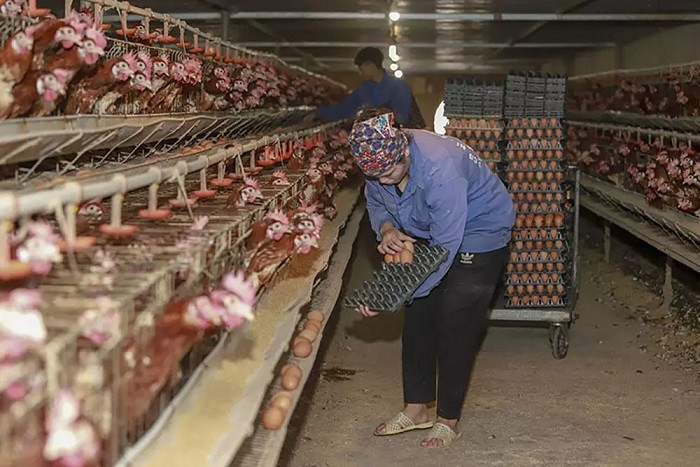During this period, the price of chickens fluctuated, and breeders broke even on only a few days, while the days experiencing losses lasted for a long time, said Mr. Le Phuong Hai, the owner of a chicken farm with about 200,000 heads in the southern province of Dong Nai.
Most recently, bran prices and freight rates have increased. This is the situation of not only millions of chicken farmers like Mr. Hai, but also hundreds of thousands of pig farmers.
Vietnam imports feed worth $9 billion

Last year, Vietnam's poultry herd increased to over 500 million heads while the number of pigs rapidly recovered to 28.1 million heads. The growth rate of the livestock industry remained at 5-6%. In addition, the aquaculture area also increased to 1.3 million hectares with an output of 4.75 million tons/year.
Accordingly, the livestock and aquaculture industry needs over 33 million tons of fine ingredients to serve industrial feed production in 2021 and this number is forecast to keep rising in 2022.
However, the domestic supply was only 13 million tons, accounting for about 40%. The remaining 22.3 million tons were imported, worth up to $9.07 billion last year. In 2019 and 2021, Vietnam imported 20,436 million and 20,185 million tons of materials for animal feed production, worth $6.02 and $6.06 billion, respectively.
In the past year, the prices for raw materials for animal feed production have increased sharply, from over 20% to 50%.
As Vietnam depends too much on imported raw materials, when the Covid-19 epidemic occurred, the supply chain broke down, the price for animal feed has rocketed. Since October 2020, the price for animal feed has increased 10 times continuously. The Russia-Ukraine conflict has pushed feed prices to new records, which are predicted to reach new peaks this year.
According to the Department of Livestock Production, the cost of animal feed accounts for 65-70% of the production cost. Therefore, when the price of this product increases from 18.4-29.8%, breeders get losses.
High production costs also make domestic livestock products unable to compete with imported products. For example, the production cost of live pigs at the present time is VND55,000-58,000/kg, higher than the price of imported pork of VND53,000/kg.
According to the Ministry of Agriculture and Rural Development, livestock production is shifting from small-scale to large-scale household farming, with the development of farm models to form livestock value chains. In 2011, Vietnam had about 4.13 million pig breeding facilities. The number reduced to about 2 million in 2020. In the past five years, the rate of household-scale husbandry has decreased by 5-7%/year.
Taking advantage of cheap domestic materials
Facing the skyrocketing price of imported raw materials for animal feed production, many solutions have been proposed such as reducing import tax and corporate income tax, etc. Deputy Minister of Agriculture and Rural Development Phung Duc Tien also called feed manufacturers that have enough imported materials to not rush to increase prices for animal feed to share the burden with farmers.
It is also recommended to adjust the livestock structure in the direction of increasing grazing cattle, reducing pigs and poultry in order to take advantage of crop by-products, biomass corn, and grass, and reduce the consumption of maize and imported feed.
Meanwhile, experts from the Institute of Livestock Production (Ministry of Agriculture and Rural Development) said that it is possible to find cheap domestic sources of raw materials to replace imported materials to produce feed. For example, Vietnam produces about 10 million tons of cassava and about 43 million tons of rice, with rice bran used to produce animal feed. If applying a mix of feed from indigenous materials, the cost to raise a pig of 93kg can fall by VND170,000 (US$8).
It is estimated that Vietnam will need about 28-30 million tons of raw materials for feed production/year in the next five years, worth $12-13 billion, with an average growth of 11-12%/year. The price of raw materials is hard to predict, so Vietnam needs a strategy to develop domestic raw materials for feed production.
Mr. Tong Xuan Chinh said that the area of corn and soybean in the country is very low. In the long term, it is necessary to convert a part of the low-efficient cropland to plant maize and cassava.
When building material areas, businesses should seek varieties of corn, cassava, soybeans, etc. with high yield and good quality. They can also invest in modern production technology to process by-products from beer residues, pineapple residues, cashew shells, coffee shells, etc., to process animal feed. This source of by-products amounts to millions of tons but has not been fully utilized.
"Only when a complete ecosystem, from breeding, input materials to output, and a consumption market is built, will the livestock industry develop sustainably," said Deputy Minister Phung Duc Tien.
Tam An